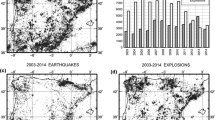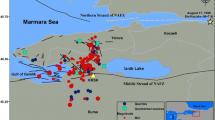Abstract
We use the dense Israel Seismic Network (ISN) to discriminate between low magnitude earthquakes and explosions in the Middle East region. This issue is important for CTBT monitoring, especially when considering small nuclear tests which may be conducted under evasive conditions. We explore the performance of efficient discriminants based on spectral features of seismograms using waveforms of 50 earthquakes and 114 quarry and underwater blasts with magnitudes 1.0–2.8, recorded by ISN short-period stations at distances up to 200 km. The single-station spectral ratio of the low and high-frequency seismic energy shows an overlap between explosions and earthquakes. After averaging over a subnet of stations, the resolving power is enhanced and the two classes of events are separated. Different frequency bands were tested; the (1–3 Hz)/(6–8 Hz) ratio provided the best discriminant performance. We also estimated normalized r.m.s. spectral amplitudes in several sequential equal frequency windows within the 1–12 Hz band and applied multiparametric automatic classification procedures (Linear Discrimination Function and Artificial Neural Network) to the amplitudes averaged over a subnetwork. A leave-one-out test showed a low rate of error for the multiparametric procedures. An innovative multi-station discriminant is proposed, based on spectral modulation associated with ripple-firing in quarry blasts and with the bubbling effect in underwater explosions. It utilizes a distinct azimuth-invariant coherency of spectral shapes for different stations in the frequency range (1–12 Hz). The coherency is measured by semblance statistics commonly used in seismic prospecting for phase correlation in the time domain. After modification, the statistics applied to the network spectra provided event separation. A new feature of all the above mentioned procedures is that they are based on smoothed (0.5 Hz window), instrument-corrected FFT spectra of the whole signal; they are robust to the accuracy of onset time estimation and, thus well suited to automatic event identification.
Similar content being viewed by others
References
Almagor, G. and Hall, J. K., 1984, Bathymetric chart of the Mediterranean coast of Israel, Geol. Surv. Bull., 77.
Bakun, W. H., Stewart, R. M. and Bufe, C. G., 1978, Directivity in the high-frequency radiation of small earthquakes, Bull. Seism. Soc. Am., 68, 1253–1263.
Barker, T. G., McLaughlin, K. C. and Stevens, J. L., 1993, Numeral simulation of quarry blast sources, SSS-TR-93-13859, S-Cubed, La Jolla, California.
Baumgardt, D. R. and Young, G. V., 1990, Regional seismic waveform discriminants and case-based event identification using regional arrays, Bull. Seism. Soc. Am. 80, 1874–1892.
Baumgardt, D. R. and Zigler, K. A., 1988, Spectral evidence of source multiplicity in explosions: application to regional discrimination of earthquakes and explosions, Bull. Seism. Soc. Am. 78, 1773–1795.
Bennett, T. J., Barker, B. W., McLaughlin, K. L. and Murphy, J. R., 1989, Regional discrimination of quarry blasts, earthquakes and underground nuclear explosions, Final Report, GL-TR-890114, S-Cubed, La Jolla, California.
Bennett, T. J. and Murphy, J. R., 1986, Analysis of seismic discrimination capabilities using regional data fromWestern United States events, Bull. Seism. Soc. Am. 76, 1069–1086.
Blandford, R. R., 1995, Regional seismic event discrimination. In: Husebye, E. S. and Dainty, A. M. (eds), Monitoring a Comprehensive Test Ban Treaty, NATO ASI Series, Series E: Applied Sciences, Kluwer Academic Publishers, Vol. 303, pp. 689–719.
Beck, S. L. and Wallace, T. C., 1995, Broadband seismic recordings of mining explosions and earthquakes in South America. In Proc. 17th Seismic Research Symposium on Monitoring a CTBT, Phillips Laboratory, Hanscom Air Force Base, MA, 12–15 Sept., Scottsdale AZ, pp. 157–163.
Chapman, M. C., Bolinger, G. A. and Sibol, M. S., 1992, Modeling delay-fired explosion spectra at regional distances, Bull. Seism. Soc. Am. 82, 2430–2447.
Cole, R. H., 1948, Underwater Explosions, Princeton University Press, 437 pp.
Dowla, F., 1995, Neural networks in seismic discrimination. In: Husebye E. S. and Dainty, A. M. (eds), Monitoring a Comprehensive Test Ban Treaty, NATO ASI Series, Series E: Applied Sciences, Kluwer Academic Publishers, Vol. 303, pp. 777–790.
Der, Z. A. and Baumgardt, D. R, 1995, Source finiteness, signal decorrelation, spectral scalloping and identification of multiple delayed explosions, Proc. 17th Seismic Research Symposium on Monitoring a CTBT, Phillips Laboratory, Hanscom Air Force Base, MA, 12–15 Sept., Scottsdale, AZ, pp. 723–732.
Ginzburg, A. and Folkman, Y., 1980, The crustal structure between the Dead Sea rift and the Mediterranean Sea, Earth Planet. Sci. Lett. 41, 181–188.
Gitterman, Y., 1982, Assessment of dynamic parameters of seismic and air shock waves from multiple shot systems, Ph.D. Thesis, Institute of Mining, Academy of Sciences of the USSR, Novosibirsk.
Gitterman, Y. and van Eck, T., 1993, Spectra of quarry blasts and microearthquakes recorded at local distances in Israel, Bull. Seis. Soc. Am. 83, 1799–1812.
Gitterman, Y. and Shapira, A., 1993, Spectral discrimination of underwater explosions, Isr. J. Earth Sci. 42, 37–44.
Gitterman, Y. and Shapira, A., 1994, Spectral characteristics of seismic events off the coast of the Levant, Geophys. J. Int. 116, 485–497.
Gitterman, Y., Pinsky, V. and Shapira, A., 1996, Discrimination of seismic sources using Israel Seismic Network, PL-TR-96-2207, Phillips Laboratory, Hanscom Air Force Base, MA, 98 pp.
Hedlin, M., Vernon, F., Minster, J. G. and Orcutt, J. A., 1995, Regional small-event identification using seismic networks and arrays, Proc. 17th Seismic Research Symposium on Monitoring a CTBT, Phillips Laboratory, Hanscom Air Force Base, MA, 12–15 Sept., Scottsdale, AZ, pp. 875–884.
Jarpe, S. P., Moran, B., Goldstein, P. and Glenn, L. A., 1996, Implications of mining practices in an open-pit gold mine for monitoring of a Comprehensive Test Ban Treaty, LLNL report UCRL-ID-123017, 35 pp.
Kim, W. Y., Simpson, D. W. and Richards, P. G., 1994, Highfrequency spectra of regional phases from earthquakes and chemical explosions, Bull. Seis. Soc. Am. 84, 1365–1386.
Li, Y., Toksöz, M. N. and Rodi, W. L., 1996, Discrimination of small earthquakes and explosions. In: Proceedings of the 18th Symposium on Monitoring a Comprehensive Test Ban Treaty, Phillips Laboratory, Hanscom Air Force Base, MA, PL-TR-96-2153, 4–6 Sept., Annapolis, pp. 574–583.
Neidell, N. S. and Taner, M. T., 1971, Semblance and other coherency measures for multichannel data, Geophysics 36, 482–497.
Pulli, J. J., 1995, Extracting and processing signal parameters for regional seismic event identification. In: Husebye, E. S. and Dainty, A. S. (eds), Monitoring a CTBT, NATO ASI Series, Series E, Kluwer Academic Publishers, Vol. 303, pp. 741–754.
Shapira, A., 1988, Magnitude scales for regional earthquakes monitored in Israel, Isr. J. Earth Sci. 37, 17–22.
Stump, B. W. and Reinke, R. E., 1988, Experimental confirmation of superposition from small explosions, Bull. Seism. Soc. Am. 78, 1059–1073.
Taylor, S. R., Sherman, N. W. and Denny, M. D., 1988, Spectral discrimination between NTS explosions and Western United States earthquakes at regional distances, Bull. Seis. Soc. Am. 78, 1563–1579.
Tsvang, S. L., Pinsky, V. I. and Husebye, E. S., 1993, Enhanced seismic source discrimination using NORESS recordings from Eurasian events, Geophys. J. Int. 112, 1–14.
Walter, W. R., Mayeda, K. M. and Patton, H. J., 1995, Phase and spectral ratio discrimination between NTS earthquakes and Explosions. Part I: Empirical observations, Bull. Seis. Soc. Am. 85, 1050–1067.
Wüster, J., 1993, Discrimination of chemical explosions and earthquakes in central Europe – a case study, Bull. Seism. Soc. Am. 83, 1184–1212.
Author information
Authors and Affiliations
Rights and permissions
About this article
Cite this article
Gitterman, Y., Pinsky, V. & Shapira, A. Spectral classification methods in monitoring small local events by the Israel seismic network. Journal of Seismology 2, 237–256 (1998). https://doi.org/10.1023/A:1009738721893
Issue Date:
DOI: https://doi.org/10.1023/A:1009738721893




